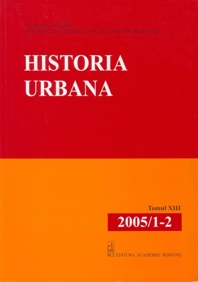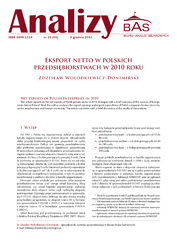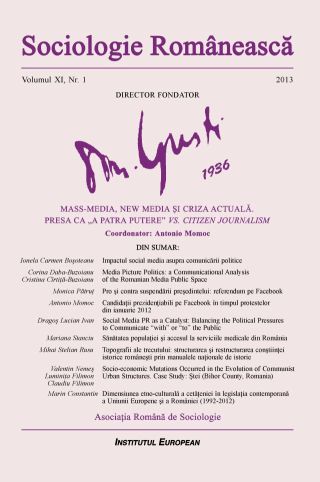
We kindly inform you that, as long as the subject affiliation of our 300.000+ articles is in progress, you might get unsufficient or no results on your third level or second level search. In this case, please broaden your search criteria.





This article reports on the net exports of Polish private sector in 2010. It begins with a brief overview of the sources of foreign trade data in Poland. Next, the author analyses the export earnings and import expenditure of Polish companies broken down by sector, employment and foreign ownership. The article concludes with a brief discussion of the results of the analysis.
More...
The establishment of the communist regime (1945-1989) triggered the shaping of a new model of development of the country, by hastening the transformation and construction of a modern and competitive state, based on two major pillars represented by heavy industry and cities. The implementation in the territory of these policies led to the emergence of “socialist urban structures”, often with monofunctional profile and artificially sustained by massive investment at the expense of other traditional urban centers. The fall of the communist regime and the rigors of adapting to market economy have triggered other mutations in the Romanian socio-economic system at all scale levels. The present study highlights the successive shocks occurred in the natural evolution of Ştei (from village to town) in this socio-economic context. In order to highlight the mutations occurred in the studied area there were used a number of demographic and economic markers. A typical exponent of the forced industrialization policies, conditioned by the proximity to uranium resources, it became Dr. Petru Groza town “overnight”, with over 5.000 inhabitants. After the fall of communism followed the progressive decline of the town occurred due to the difficulties to adapt the heavy industry to the market economy, simultaneously with the diminishing of the uranium resources. The socio-economic situation of the last decades illustrates the identity crisis facing the town after the loss of its economic identity. The revitalization of the town of Ştei depends directly on the development policies and the urban regeneration process, based on its real potential.
More...
Starting from the assumption that the social management of historical time is a powerful tool in the political definition of reality, this paper analyzes how the history of the Romanian people has been periodized through the course of time. The central argument states that the partitioning system used to periodize the past harbors a hidden agenda, or a particular ideological „implicature”, that can be brought to light by analyzing the temporal watersheds selected as defining moments in the history of that community. The paper analyzes the social logic of periodization operating within the Romania national history textbooks, revealing how socio-political conditions determine the temporal structuring of the past. Moreover, it shows how social change, and especially the change of the socio-political regime, leads to a revertebration of the past’s symbolic backbone. Dramatic social and political change results in reconfiguring the formal structure of the collective consciousness concerning the past, within which specific events of Romanian history acquire their meaning. In conclusion, the study shows that, although resorting to a system of periodization is indeed a cognitive prerequisite for understanding the past, the reality of the past does not come with an already-there articular structure, so that „carving the (past’s) reality at its joints”, as Plato put it, is not a possibility.
More...


This article shows some of the contrasts among the Romanian quality of health services and that from European Community. Through its medical practices and critical health state of its population, Romania seems deeply dissociated from European Union realities in this respect. Since two decades, the Romanian public health system is situated at the tail-end of the European systems in what concerns social prevention, care for population’s health, application of some sanitary public programmes and performances of the medical services providing. And all these after about twenty years of health services reform, and multiplying of public health care spending of five times. The article includes two chapters focused on some health and demographic indicators, and on the existing difficulties in accessing public health services encountered by various disadvantaged categories of population – with an accent on some new research data concerning the access of the Rroma ethnic group to the public health services. There are used data published by Eurostat, but also from the national and territorial health statistics.
More...

The paper „The impact of social media on political communication” aims to emphasize the changes brought by new technologies, via social media, to political communication, as an unprecedented transformation of the communication between a politician and the ordinary potential elector. Following the rise of the internet and the success of social networks, political communication adapted to the web structure by means of the online interaction of the two actors in the public scene. Social media is a relatively new concept, used rather than defined in the specialised literature. Therefore, after a brief definition and a diachronic presentation of the concept, we intend to describe the new features of political communication used by politicians by means of new communication techniques, providing examples wherever possible. New media, a form of mass communication, was a constant topic of our concern, and, therefore, approaching the social media phenomenon is nothing but a natural consequence of our previous studies. The article is structured into two chapters, as follows: The first chapter deals with the social media phenomenon and the changes it brought to political communication. The second chapter concerns the social media – political communication which will highlight the reviving of political communication through social media, leading us to assert that, through social media, political communication tends to become – in Dominique Boullier’s terms – net-politique (internet politics). The bibliographic references we made use of in describing this theme come from the Anglofrancophone research area, but also from the Romanian specialised literature.
More...
My article is conceived as a comparative assessment of the implications that the European Union enlargement in 2007 has entailed upon the ethno-national belongingness among Romanian nationality and ethnic minorities in Romania. The cultural identity of ethnic and linguistic communities is currently related to the statute of European Union citizenship, as established by the article 8 of the Maastricht Treaty of European Union (1992). In such socio-economic and legislative framework, the anthropological theorizing of ethnicity and “cosmopolitanism”, alongside that of the “human rights” and the “national minorities”, actually approximates the ethno-cultural dimension of the European and national citizenship, in the historical continuity and development of the European national states, as well as within their institutional structuring, once they have adhered to a European community. The equivalence and communication between the terminology of European and national legislation (with its specialized juridical principles) endorse the European conceptualization of national citizenship, and, at the same time, the national intelligibility of European citizenship. To exemplify, the official language of Romanian state is also one of the official languages of Europen Union, which is the same as the recognition by the Constitution of Romania of the minorities’ right to use their maternal languages in justice. Similarly, the ethnic, cultural, linguistic, and religious identity compose the “configuration” of ethnonationality in the Framework Convention for the Protection of National Minorities, in the Constitution of Romania, and in the draft Statute of National Minorities in Romania as well.
More...
Our paper implies a comparative analysis of the Romanian media public space in the years 2011 and 2012, by pointing out the process, actors and themes of the communication. We inquire whether we have real communication autonomy in the public space and how public space’ actors relate with journalists and politicians. We are interested in understanding how citizens and opinion leaders succeed to communicate and state their position, but also what are the themes they choose. The methodology is content analysis, with which we investigated the content of the messages within the media public space in Romania, the actors and the mechanisms of the communication. Also, our study implies a communication analysis of the public space, as it uses a content analysis method specific to public relations, communications lifecycle, developed by David Michaelson and Toni L. Griffin, in order to analyse the efficiency of the communication. Our study shows that there is a strong connection between the themes communicated by public space’s actors and the topics spread out by the media. Moreover, we see that media is dominated by political messages, which have an important influence on the message content of the public space’ actors, who don’t seem to succeed in imposing new themes, or to generate a real debate on the issue at matter. Finally, our paper reconsiders the debate on the public space and the media public space, for a better understanding of their dynamics and communication mechanisms.
More...
Romania is in a process of consolidating the institutions of the rule of law. The recent initiative of the President of Romania regarding the revision of the Constitution of Romania, which marks the concerns regarding the constitutional evolution in our country, stands as proof. The project regarding the revision has been subjected to the Constitutional Court’s control, and in the following paragraphs, I will present the main objectives of the revision and the Constitutional Court’s assessments regarding this.
More...
The New Civil Code changes two big paradigms of the romanian legal system, thereupon: (i) the Civil Code is applicable to the relations between common citizen, being enforced in legal business relations only as a general rule, meaning in addition to the commercial Code or to the special commercial laws destinated to the business relations; (ii) each individual has only one patrimony, the assets which compose it are for the general and concursual guaranty, but egalitarian, of the creditors. The professional and the enterprise, the two technical notions which replace the notions of trade and merchant, are not defined, although the need of definitions was more than obvious, because it is necessary to know what is the professional in relation to the common individual and what the entrprise is in relation to the simple activity, whatever this might be.
More...
We intend to present, in the following article, the amendments brought to the Labour Code by Law nr. 40/2011 in relation to its defined purpose and also in terms of the effects which can be produced in pratice upon the labour contacts. We will try to unravel the vague provisions and to find solutions of interpretation and enforcement, taking into considerantion the problems that occur in practice, the points of view expressed in the legal literature and caselaw, the provisions of the European Directives aplicable in the labour contacts field and the caselaw of the Court of Justice of the European Union.
More...
In Mircea v. Romania, Spînu v. Romania, Dănilă v. Romania suits, The European Court of Human Rights has settled that there was a violation of art. 6 parag. 1 of the Convention regarding the right to a fair trial, because the Supreme Court of Justice sentenced the accused without a hearing and without administrating the evidence in the appeal. Random or not, all this convictions concern judments delivered in appeal by the Supreme Court. I consider that these convictions don’t represent an analysis of the Strasbourg Court regarding the fact fairness of the trial, but rather it reflects the Court’s opinion regarding the possiblity of the last court to aggravate the defendant’s situation without administrating evidence, an opinion resulting form a different perception of the procedural rules of the appeal. For a better understanding, I will draw a short history of the appeal and an analysis of the possibilites to aggravate the defendant’s situation in this phas eof the trial.
More...
The problem of the “dialogue” between the Constitutional Court of Romania and the doctrine, between its jurisprudence and the opinions expressed by certain experts regarding the solutions adopted by the Constitutional Court, is discussed in two parts of this article: (i) A coherent dialogue; (ii) A complex dialogue, in which the Court is sometimes compelled to take into account political interests. “A coherent dialogue” is considered to be the one regarding the solutions given by the Constitutional Court in interpreting the rule according to which “the resolution given to the issues of law presented is mandatory for the courts” (art. 329 paragraph 3 final phrase of the Code of Civil Procedure). “A complex dialogue, in which the Court is sometimes compelled to take into account political interests” is illustrated by mentioning the decisions given by the Constitutional Court in resolving certain legal conflicts of a constitutional nature between the President of Romania and the Prime Minister (according to art. 146 letter e of the Constitution) and, especially, by discussing the decisions taken according to the article mentioned above, on the occasion of the notification of the Constitutional Court of the unconstitutionality of Government liability regarding a bill that has already been debated by the Parliament and that has already been discussed by the Chamber of Deputies and through doctrinarian disapproval of these decisions (no. 1431, November 3, 2010 and no. 1525, November 24, 2010 decisions of the Constitutional Court).
More...
On the 1st of January 2012, the new Rules of Arbitration of the International Chamber of Commerce – ICC2came into force, designed to replace the procedural rules of the previous rules of arbitration, which came into force in 1998. The New Rules govern the resolution of arbitral disputes promoted under its empire, except for the situation when the parties have agreed for the disputes to abide rules in force at the time of signing of the arbitral convention. Hereinafter, we will resume at indicating the modifications which have been made by the New Rules in relation to the rules from 1998 and its expected impact.
More...